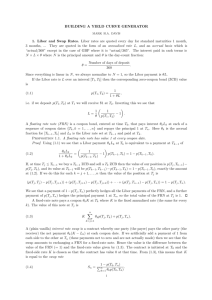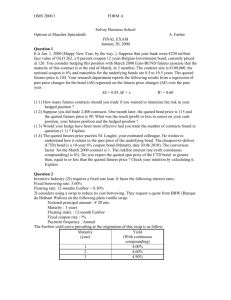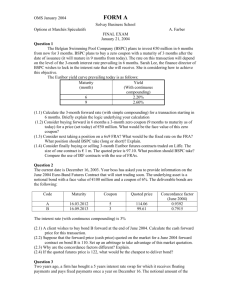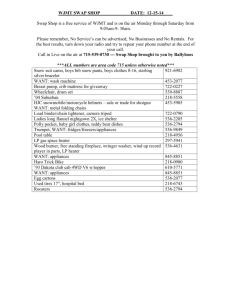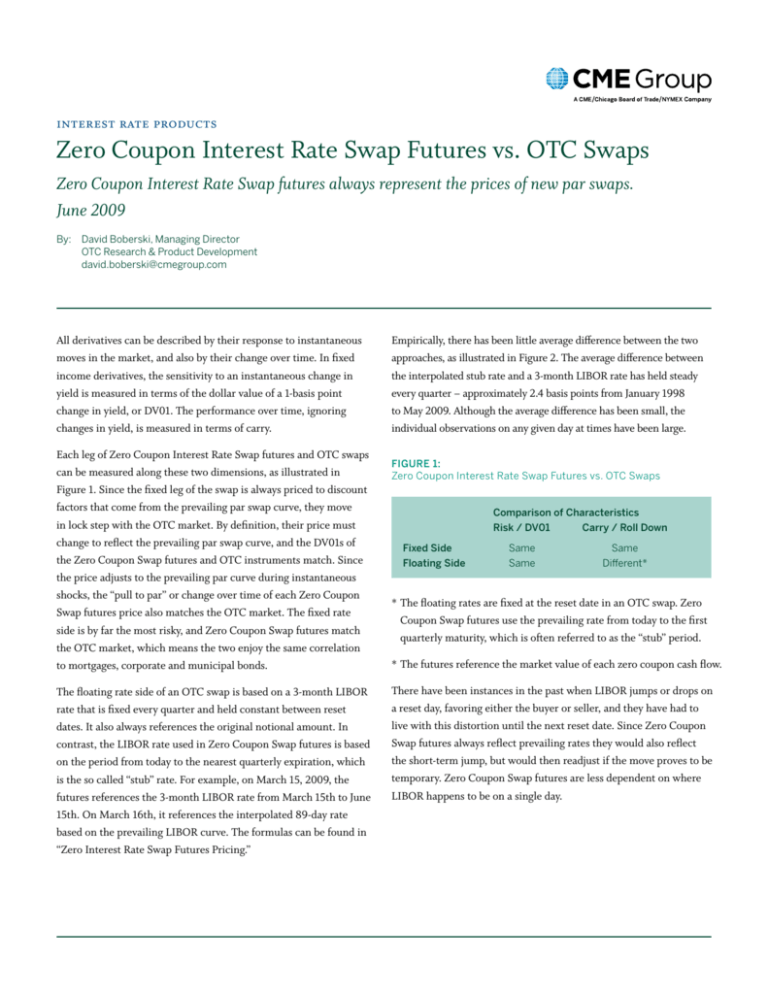
interest rate products
Zero Coupon Interest Rate Swap Futures vs. OTC Swaps
Zero Coupon Interest Rate Swap futures always represent the prices of new par swaps.
June 2009
By: David Boberski, Managing Director
OTC Research & Product Development
david.boberski@cmegroup.com
All derivatives can be described by their response to instantaneous
moves in the market, and also by their change over time. In fixed
income derivatives, the sensitivity to an instantaneous change in
yield is measured in terms of the dollar value of a 1-basis point
change in yield, or DV01. The performance over time, ignoring
changes in yield, is measured in terms of carry.
Each leg of Zero Coupon Interest Rate Swap futures and OTC swaps
can be measured along these two dimensions, as illustrated in
Figure 1. Since the fixed leg of the swap is always priced to discount
factors that come from the prevailing par swap curve, they move
in lock step with the OTC market. By definition, their price must
change to reflect the prevailing par swap curve, and the DV01s of
the Zero Coupon Swap futures and OTC instruments match. Since
the price adjusts to the prevailing par curve during instantaneous
shocks, the “pull to par” or change over time of each Zero Coupon
Swap futures price also matches the OTC market. The fixed rate
side is by far the most risky, and Zero Coupon Swap futures match
the OTC market, which means the two enjoy the same correlation
to mortgages, corporate and municipal bonds.
The floating rate side of an OTC swap is based on a 3-month LIBOR
rate that is fixed every quarter and held constant between reset
dates. It also always references the original notional amount. In
contrast, the LIBOR rate used in Zero Coupon Swap futures is based
on the period from today to the nearest quarterly expiration, which
is the so called “stub” rate. For example, on March 15, 2009, the
futures references the 3-month LIBOR rate from March 15th to June
15th. On March 16th, it references the interpolated 89-day rate
based on the prevailing LIBOR curve. The formulas can be found in
“Zero Interest Rate Swap Futures Pricing.”
Empirically, there has been little average difference between the two
approaches, as illustrated in Figure 2. The average difference between
the interpolated stub rate and a 3-month LIBOR rate has held steady
every quarter – approximately 2.4 basis points from January 1998
to May 2009. Although the average difference has been small, the
individual observations on any given day at times have been large.
Figure 1:
Zero Coupon Interest Rate Swap Futures vs. OTC Swaps
Comparison of Characteristics
Risk / DV01 Carry / Roll Down
Fixed Side Floating Side Same
Same
Same
Different*
*The floating rates are fixed at the reset date in an OTC swap. Zero
Coupon Swap futures use the prevailing rate from today to the first
quarterly maturity, which is often referred to as the “stub” period.
*The futures reference the market value of each zero coupon cash flow.
There have been instances in the past when LIBOR jumps or drops on
a reset day, favoring either the buyer or seller, and they have had to
live with this distortion until the next reset date. Since Zero Coupon
Swap futures always reflect prevailing rates they would also reflect
the short-term jump, but would then readjust if the move proves to be
temporary. Zero Coupon Swap futures are less dependent on where
LIBOR happens to be on a single day.
Zero Coupon Interest Rate Swap Futures vs. OTC Swaps
A second difference between the OTC and Zero Coupon Swap
futures markets has to do with the notional amount referenced in the
LIBOR calculation. OTC swaps always reference the same notional
amount, which is effectively the face value of the swap. Zero Coupon
Swap futures function more like LIBOR financed bonds, and where
the LIBOR interest is applied to the current market value rather
than to the face amount. The implication is that the carry over time
between OTC and Zero Coupon Swap futures will be different for an
“off coupon” swap.
While it is true that the slope of the back-end of the curve has been
positive much of the time, the front-end of the curve has been much
more volatile. Volatility does not favor either the buyer or seller, and
while this design aspect is different than OTC swaps, it references
only prevailing rates.
Figure 2:
Snapshot of spot rates, implied forward rates and interpolated
discount factors.
1-week LIBOR
1-month LIBOR
3-month LIBOR
8.00
• Throughout the currency crisis in 1998, the tech bubble bursting
in 2001 to today’s credit crisis, there has never been a systematic
divergence between the rates shown, but differences have
lingered for substantial periods.
• A payer of fixed interest on an OTC swap receives the same
3-month LIBOR rate between reset dates.
• A buyer of Zero Coupon Swap futures pays the “stub” rate from
today to the first reset date.
• Combining these two positions effectively nets the DV01 of the
two fixed rate sides and finances a 3-month LIBOR rate at the
prevailing LIBOR “stub” rate, creating a carry trade.
• This carry trade may or may not be profitable, depending on the
slope of the LIBOR curve.
• Carry trades are not “arbitrage” trades because they do not offer
riskless profits, especially in the volatile front-end of the curve.
7.00
Yield %
• Over the period shown there have been dramatic changes to
the shape of the front-end of the curve that led to differences
between overnight and term rates.
6.00
5.00
4.00
3.00
2.00
1.00
0.00
Jan-98 Jan-99 Jan-00 Jan-01 Jan-02 Jan-03 Jan-04 Jan-05 Jan-06 Jan-07 Jan-08 Jan-09
Source: British Bankers’ Association
For more information on Zero Coupon Interest Rate Swap futures,
visit www.cmegroup.com/zeroswaps.
Futures trading is not suitable for all investors, and involves the risk of loss. Futures are a leveraged investment, and because only a percentage of a contract’s value is required to trade, it is possible to lose more than the amount
of money deposited for a futures position. Therefore, traders should only use funds that they can afford to lose without affecting their lifestyles. And only a portion of those funds should be devoted to any one trade because they
cannot expect to profit on every trade.
CME Group is a trademark of CME Group Inc. The Globe logo, CME, Chicago Mercantile Exchange and Globex are trademarks of Chicago Mercantile Exchange Inc. CBOT and Chicago Board of Trade are trademarks of the Board of
Trade of the City of Chicago. NYMEX and New York Mercantile Exchange are trademarks of New York Mercantile Exchange Inc. All other trademarks are the property of their respective owners. The information within this brochure
has been compiled by CME Group for general purposes only. CME Group assumes no responsibility for any errors or omissions. Additionally, all examples in this brochure are hypothetical situations, used for explanation purposes
only, and should not be considered investment advice or the results of actual market experience. All matters pertaining to rules and specifications herein are made subject to and are superseded by official CME, CBOT and NYMEX
rules. Current rules should be consulted in all cases concerning contract specifications.
Copyright © 2009 CME Group. All rights reserved.
IR247.4/0/0709

